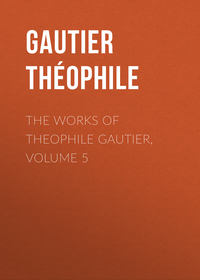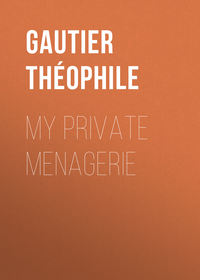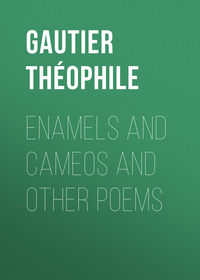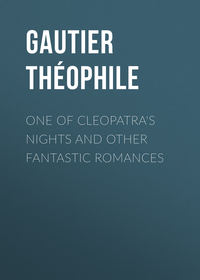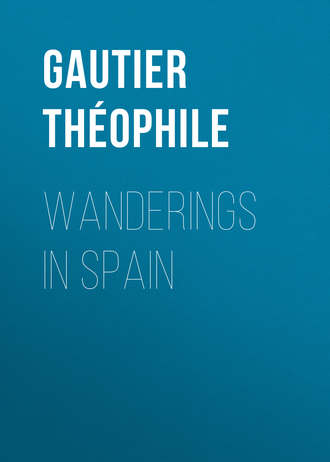 полная версия
полная версияWanderings in Spain
Every vehicle in the town is laid under contribution, for it is accounted the height of fashion by the manolas, who are the grisettes of Madrid, to proceed in a calesin to the Plaza de Toros: they pawn even their mattresses to obtain money on the day of a bull-fight, and without being exactly virtuous the rest of the week, they are most decidedly much less so on Sunday and Monday. You also see country people who have come to town on horseback, with their carbine suspended at the bow of their saddle; others, again, either alone or with their wives, are mounted on asses. Besides all these persons, there are the carriages of the fashionable world, and a whole host of honest citizens and señoras in mantles on foot, who quicken their pace on perceiving the mounted National Guard, headed by their trumpeters, advancing to clear the arena. For nothing in the world would any one miss seeing the clearing of the arena, and the precipitate flight of the alguazil after he has thrown to the helper the key of the toril, where the horned gladiators are confined. The toril is situated opposite the matadero, in which place they flay the animals that have been killed. The bulls are driven, the night before the fight, to a meadow called el arroyo, near Madrid. This meadow is a favourite walk with the aficionados; but it is one, by the way, not wholly free from danger, for the bulls are at liberty, and their drivers find it rather a difficult task to keep them in order. Lastly, the bulls are conducted into the encierro (stable attached to the circus) by the aid of old bulls used to the office, and scattered among the herd of their wild brethren.
The Plaza de Toros is situated on the left-hand side of the road, beyond the Puerta d'Alcala (which, I may mention in a parenthesis, is a fine structure, resembling a triumphal arch, with trophies and other heroic ornaments); it is an enormous circus, with whitewashed walls, presenting no remarkable feature on the outside. As all the tickets are taken beforehand, the audience enter without the least confusion, and every one clambers to his place, and sits down according to the particular number of his ticket.
The interior is arranged in the following manner: – Around the arena, which is of truly Roman grandeur, runs a circular barrier of planks, six feet high, painted a bright red, and furnished on each side, at about two feet from the ground, with a wooden ledge, on which the chulos and banderilleros put one foot, in order to jump over to the other side when they are followed too closely by the bull. This barrier is called las tablas. It has four doors, for the entrance of the officials and the bulls, as well as for carrying off the bodies, &c. Beyond this barrier there is another, rather higher. The space between the two forms a kind of corridor, where the chulos rest themselves when they are fatigued; it is likewise the station of the picador sobresaliente (substitute), whose duty it is always to hold himself in readiness, fully dressed and equipped, in case the chief picador should be killed or wounded; and also of the cachetero and a few aficionados, who, by dint of perseverance, succeed, despite the rules, in smuggling themselves into this blest place, admittance into which is as much sought after in Spain as is the privilege of going behind the scenes of the opera at Paris.
As it frequently happens that the bull, when exasperated, clears the first barrier, the second is surmounted by a network of ropes to prevent his leaping further; and a number of carpenters with axes and hammers are always at hand to repair any damage done to the enclosure, so that accidents are almost impossible. However, bulls de muchas piernas (of much legs), as they are technically called, have been known to clear the second barrier. We have an instance of this in an engraving of the Tauromaquia of Goya, the celebrated author of the "Caprices," representing the death of the alcade of Torrezon, who was miserably gored by one of these leaping gentry.
The seats destined for the use of the public are situated immediately beyond the second barrier. Those near the ropes are called plazas de barrera, those in the middle tendidos, while those next to the first tier of the grada cubierta are distinguished by the appellation of tabloncillos. All these rows, which remind you of the seats in the Roman amphitheatres, are composed of bluish granite, and have no covering but the canopy of heaven. Immediately behind them are the covered places, gradas cubiertas, which are divided into delantera, first seats; centro, middle seats; and tabloncillo, seats with backs. Above these are the boxes, called palcos and palcos por asientos. They are a hundred and twenty in number, very spacious, and capable of containing twenty persons each. The difference between the palco por asientos and the simple palco is, that in the former you can take a single place as you can a balcony-stall at the opera. The boxes of the Reina Gobernadora y de la Innocente Isabel are decorated with silk hangings and closed by curtains. Next to them is the box of the ayuntamiento (municipal authorities), who preside over the sports, and whose duty it is to settle any dispute that may arise.
The circus, thus arranged, contains twelve thousand spectators, all seated at their ease, and enjoying a clear view of everything going forward, – a most indispensable condition in an amusement that is purely ocular. The immense building is always full; and those who are unable to procure plazas de sombra (places in the shade) prefer being broiled alive in the uncovered seats, to missing one fight. It is considered as indispensable by those persons who pride themselves on their gentility to have a box at the bull-fights in Madrid, as it is by Parisians of fashion to possess one at the Italian Opera.
On issuing from the outward corridor to proceed to my place, I was seized with a sort of sudden giddiness. The circus was bathed in torrents of light, for the sun is a chandelier of a very superior description, which possesses the advantage of not spilling the oil upon those beneath, and which not even gas will supersede for some time to come. An immense humming floated like a fog of noise over the arena. On the sunny side of the building palpitated and glistened thousands of fans and little round parasols with handles made of reed. They looked like flocks of birds, of ever-varying hues attempting to fly. There was not one place empty. I can assure the reader that it is in itself a grand sight to see twelve thousand people assembled in a theatre of such a size, that heaven alone is capable of painting the ceiling with the blue which it procures from the palette of eternity.
A detachment of the cavalry of the National Guard, exceedingly well mounted and equipped, now rode round the arena, preceded by two alguazils in their costume, which consists of a large broad-brimmed hat and feather, in the style of Henri IV., black doublet and cloak, and large boots. Their duty was to drive away some few obstinate aficionados and certain dogs that were still loitering in the ring. As soon as this was effected, the alguazils went and fetched the toreros, under which term are included the picadores, chulos, banderilleros, and the espada, who is the principal performer in the drama. These personages made their entry to a flourish of trumpets. The picadores were mounted on horses with their eyes hooded, as the sight of the bull might frighten them and cause them to shy, thereby endangering the safety of their riders. The costume of the picadores is highly picturesque. It is composed of a short vest, which does not button, of orange, carnation, green or blue velvet, loaded with gold or silver embroidery and spangles, fringe, filigree buttons and ornaments of all kinds, especially on the shoulders, where the stuff is completely hidden beneath a glittering and phosphorescent mass of twisted arabesque-work. Under this is a waistcoat in the same style, a frilled shirt, a variegated neck-handkerchief tied carelessly round the neck, and a silk sash round the waist. Their pantaloons are of fawn-coloured buff, stuffed inside and lined with thin metal plates, like the boots of the French postilions, in order to protect the wearers' legs from being gored by the bull. A grey, low-crowned hat (sombrero), with an immense brim, and ornamented with an enormous tuft of favours, and a large mesh or net of black ribbons, which is called, I believe, a moño, and holds the hair gathered up in a pigtail at the back of the head, complete the dress. The picador is armed with a lance, at the end of which is an iron spike two or three inches long. This spike cannot wound the bull dangerously, but is enough to irritate or keep him at bay. A piece of leather fitted to the picador's hand, prevents the lance from slipping. The saddle rises very high, both behind and before, and resembles those strengthened with iron plates, in which the knights of the Middle Ages used to be buried in the tournaments. The stirrups are made of wood, and form a kind of shoe, like the Turkish stirrups. A long, iron spur, as sharp as a dagger, is fixed in the rider's heel. An ordinary spur would not be sufficient to govern the horses, who are often half dead.
The chulos present a very nimble and natty appearance with their breeches of green, blue, or rose-coloured satin, their jacket ornamented with various patterns and flowers, their tight girdle, and their little montera cocked knowingly on one ear. On their arm they carry a piece of cloth (capa), which they unroll and agitate before the bull's eyes for the purpose of exciting, dazzling, and deceiving him. They are all young men, well built, spare and slim, differing in this respect from the picadores, who are, in general, remarkable for their height and athletic proportions; the picadores require strength, and the chulos agility.
The banderilleros wear the same costume as the chulos. It is their especial duty to plant a kind of dart, tipped with an iron barb and ornamented with pieces of paper, in the bull's shoulder. These darts are called banderillas, and are employed to revive the animal's fury and lash him up to the pitch of exasperation necessary to make him present a fair aim to the sword of the matador. The banderillero has to plant two banderillas at a time; in order to do this, he must pass his two arms between the bull's horns, a delicate kind of operation, in performing which it might, perhaps, be rather dangerous for a person to be thinking of anything else.
The espada differs from the banderilleros only by the fact of his having a richer and more highly ornamented costume, which is sometimes of purple silk, a colour particularly offensive to the bull. His weapons consist of a long sword, with a handle in the shape of a cross, and a piece of scarlet cloth stretched on a long stick; the technical term for this kind of waving shield, is muleta. The reader is, at present, acquainted with the theatre and the actors. I will now show the latter enacting their various parts.
The picadores, escorted by the chulos, first go up and bow to the box of the ayuntamiento, whence the keys of the toril are thrown out to them. These are picked up and delivered to the alguazil, who gives them to the groom of the ring, and then gallops off as hard as he can, pursued by the shouts and cries of the crowd; for the alguazils, as well as all the other representatives of justice, are not much more popular in Spain than the gendarmes and sergents-de-ville are in France. Meanwhile, the two picadores take up their position to the left of the door of the toril, which is situated directly opposite the royal box, because the bull's entry is one of the most interesting parts of the fight. The picadores are stationed at a very little distance from each other, with their backs to the tablas, firmly seated in their saddles, holding their lances couched, and valiantly prepared to receive the beast. The chulos and banderilleros station themselves at some distance off, or disperse themselves over the arena.
All these preparations, which appear longer in description than they are in reality, excite the curiosity of the public to the highest pitch. Every person looks anxiously at the fatal door, and out of the twelve thousand spectators present, not one takes his eyes off it. At this moment, the loveliest woman in the world might beg in vain for a single glance.
For my own part, I frankly confess that I felt as oppressed as if my heart had been clutched by some invisible hand. I experienced a strange buzzing in my ears, and the perspiration, alternately hot and cold, ran down my back. I never felt more excited in my life.
A shrill flourish of trumpets was now heard; the red folding-doors were thrown wide open with a loud noise, and the bull rushed into the arena, in the midst of an immense hurrah.
He was a superb animal, with a glossy coat, almost black, an enormous dewlap, a square muzzle, sharp, polished, curving horns, clean-made legs, and a tail that was always in motion. Between his shoulders he had a bunch of ribbons, fastened by a large pin, and representing the colours of his ganaderia. Dazzled by the light of day, and astonished at the tumult, he stopped short for a second, and snuffed the air twice or thrice; then, perceiving the nearest picador, he made a furious bound, and tore towards him at full gallop.
The picador who was thus singled out was Sevilla. I cannot refrain from taking this opportunity to describe this famous Sevilla, who is really the beau-ideal of his class. Imagine a man of about thirty years of age, of a noble expression and demeanour; as robust as Hercules, as bronzed as a mulatto, with superb eyes, and a physiognomy like that of one of Titian's Cæsars. The expression of jovial, contemptuous serenity in his features and bearing, had really something heroic about it. On this occasion he was dressed in an orange-coloured jacket, embroidered and laced with silver; the remembrance of this jacket has ever since remained, even in its minutest details indelibly fixed on my mind. He lowered his lance, and, couching it, sustained the shock of the bull so victoriously, that the savage animal staggered and passed by him, bearing away with him a wound which, ere long, streaked his black coat with red. He stopped, as if uncertain what to do, for a few seconds, and then, with redoubled fury, rushed at the second picador, who was stationed at a little distance further on.
Antonio Rodriguez gave him a tremendous thrust with his lance, and inflicted a second wound just beside the first, for it is only allowable to hit the bull in the shoulder. But he again rushed towards Rodriguez with his head near the ground, and plunged his horn right into the horse's belly. The chulos ran up, waving their pieces of cloth, and the stupid animal, attracted and diverted by this fresh object, turned round and pursued them at full speed; but the chulos, placing one foot on the ledge we have already described, leaped lightly over the barrier, leaving him very much astonished at no longer seeing any one.
The horn had completely ripped up the horse's belly, so that his entrails came through, and almost touched the ground. I thought that the picador would retire and procure another steed; this was, however, far from being the case; he touched his ear, to see whether or not the wound was mortal. The horse was only unseamed; although his wound was most horrible to behold, it could be healed. The entrails are replaced in his belly, a needle and thread are passed through the skin, and the poor creature is still capable of being used again. Rodriguez gave him the spur, and cantered up to take another position at a little distance off.
It now seemed to strike the bull that all he should get from the picadores were hard thrusts, and he began to feel a desire to return to his pasture. Instead of entering again without hesitation, after making a few bounds, he returned, with the most dogged resolution, to his querencia; the querencia is the technical term for some corner or other that the bull chooses for a resting-place, and to which he always retires after having made the cogida. This word is employed to designate the attack of the bull, while la suerte is used in speaking of the torrero, who is likewise named diestro.
A swarm of chulos ran up and waved their bright-coloured capas before the bull's eyes; one of them was even insolent enough to wrap his cloak, that was rolled up, round the animal's head, making him look exactly like the sign of the Bœuf à la mode, which most people have seen at Paris. The bull was furious, and got rid, in the best way he could, of this ill-timed ornament, throwing the innocent piece of stuff into the air, and trampling on it with great rage when it fell on the ground. Taking advantage of this new access of fury, a chulo began irritating him, and drew him towards the picadores. On finding himself face to face with his foes, the bull hesitated, and then, making up his mind, rushed at Sevilla with such force that the horse fell with his four feet in the air, for Sevilla's arm is a buttress that nothing can bend. Sevilla fell under the horse, which is the best manner of falling, because the rider is then protected from the bull's horns, the body of his steed serving him as a shield. The chulos came up, and the horse got off with only a gash in his thigh. They raised Sevilla, who clambered into his saddle again with the greatest coolness imaginable. The horse of Antonio Rodriguez, the other picador, was less fortunate; he received so severe a thrust in the breast that the bull's horn entered up to the root, and disappeared entirely in the wound. While the bull was endeavouring to free his head from the body of the horse, Antonio clung to the edge of the tablas, which he cleared, thanks to the chulos, for when a picador is thrown, he is so weighed down by the iron lining of his boots that he finds it as difficult to move as did the knights of old when encased in their armour.
The poor horse, left to himself, crossed the arena, staggering as if he had been drunk, and entangling his feet in his entrails. A flood of black blood gushed impetuously from his wound, marking the sand with intermittent zigzag lines, which attested the unequalness of his course. At length he fell near the tablas. Two or three times he raised his head and rolled his blue eyes, that were already glazed, drawing back his lips, white with foam, and exposing his fleshless teeth. He struck the ground feebly with his tail, while his hind legs moved convulsively and kicked out for the last time, as if he wished to break the thick skull of Death with his hard hoof. He was hardly dead when the muchachos on service, seeing that the bull was engaged somewhere else, ran up and took off his saddle and bridle. He remained thus, lying on his flank, like some dark outline upon the sand. He was so slight, so flat, that he might have been mistaken for a profile cut out of black paper. I had already remarked, at Montfaucon, what strangely fantastic forms horses assume after death. Of all animals there are certainly none whose dead bodies are so melancholy to look at as that of a horse. His head, that is so noble and pure in form, is so modelled and flattened by the terrible hand of Nothingness that it seems as if it had been inhabited by a human mind; while his dishevelled mane and streaming tail have something picturesque and poetical about them. A dead horse is a corpse; every other animal that has once ceased to live is nothing more nor less than carrion.
I dwell thus upon the death of this horse, because it excited in me a more distressing feeling than anything else I ever saw at a bull-fight. But this horse was not the only victim that day. Fourteen others were stretched dead in the arena, one bull alone killing five.
The picador returned on a fresh horse, and a number of attacks, more or less successful, then ensued. But the bull was beginning to be tired, and his fury to abate, whereupon the banderilleros advanced with their darts, furnished with little pieces of paper, and in a short time the bull's neck was ornamented with a collar of pennons, which all his efforts to shake off only fixed more firmly. A little banderillero of the name of Majaron was particularly bold and successful in discharging his darts, and sometimes he would even cut an entrechat before retiring: as a natural consequence, he was greatly applauded. When the bull had seven or eight banderillas fluttering about him, and felt his skin pierced by their darts, and heard the rustling of their paper pennons in his ears, he began to run about in all directions, and bellow in the most horrible manner. His black muzzle became white with foam, and, in his blind fury, he butted so violently against one of the doors, that he broke it off its hinges. The carpenters, who were closely watching his movements, immediately replaced it, while a chulo enticed him in another direction; but was pursued so closely, that he had scarcely time to clear the barrier. The bull, exasperated and lashed to the highest pitch of fury, made one prodigious effort and followed him over the tablas. All the persons in the intermediate space jumped with marvellous rapidity into the arena, while the bull, receiving on his passage a shower of blows from the sticks and hats of the first row of spectators, re-entered by another door.
The picadores now retired, leaving a free field to the espada, Juan Pastor, who proceeded to salute the box of the ayuntamiento, and requested permission to kill the bull. As soon as this was granted, he threw his montera into the air, as much as to say that he was about to stake everything upon a single cast, and then walked up to the bull with a deliberate step, concealing his sword under the red folds of his muleta.
The espada now waved his piece of scarlet cloth several times, and the bull rushed blindly at it. By a mere movement of his body, the espada avoided the animal's attack. The latter soon returned, however, butting furiously at the light cloth, which he pushed on one side, without being able to pierce it. The favourable instant was come: the espada placed himself exactly opposite the bull, waving his muleta with his left hand, and holding his sword horizontally, with the point on a level with the animal's horns. It is difficult to convey by words an idea of the fearful curiosity, the frantic attention produced by this situation, which is worth all the plays Shakspeare ever wrote. A few seconds more, and one of the two actors will be killed! Which will it be, the man or the bull? There they stand, face to face; the man has no defensive weapon of any kind, he is dressed as if he were going to a ball, in pumps and silk stockings. A woman's pin would pierce through his satin jacket; a mere rag and a slight sword are all that he has to save his life. In this fight all the material advantages belong to the bull, who possesses two terrible horns as sharp as daggers, immense force, and that animal fury which is not conscious of danger. But then, on the other hand, the man has his sword and his courage; the eyes of twelve thousand spectators are fixed upon him, and in a few moments, young and beautiful women will applaud him with their delicate white hands.
The muleta was suddenly thrown on one side, leaving the matador's body exposed to view; the bull's horns were not an inch from his breast; I thought he was lost. A silvery flash passed with the rapidity of lightning between the two crescents, and the bull fell upon his knees with a roar of pain. He had got the hilt of the sword between his shoulders, just as the stag of Saint Hubert is represented in Albert Dürer's marvellous engraving, bearing a crucifix in the midst of his branching antlers.


